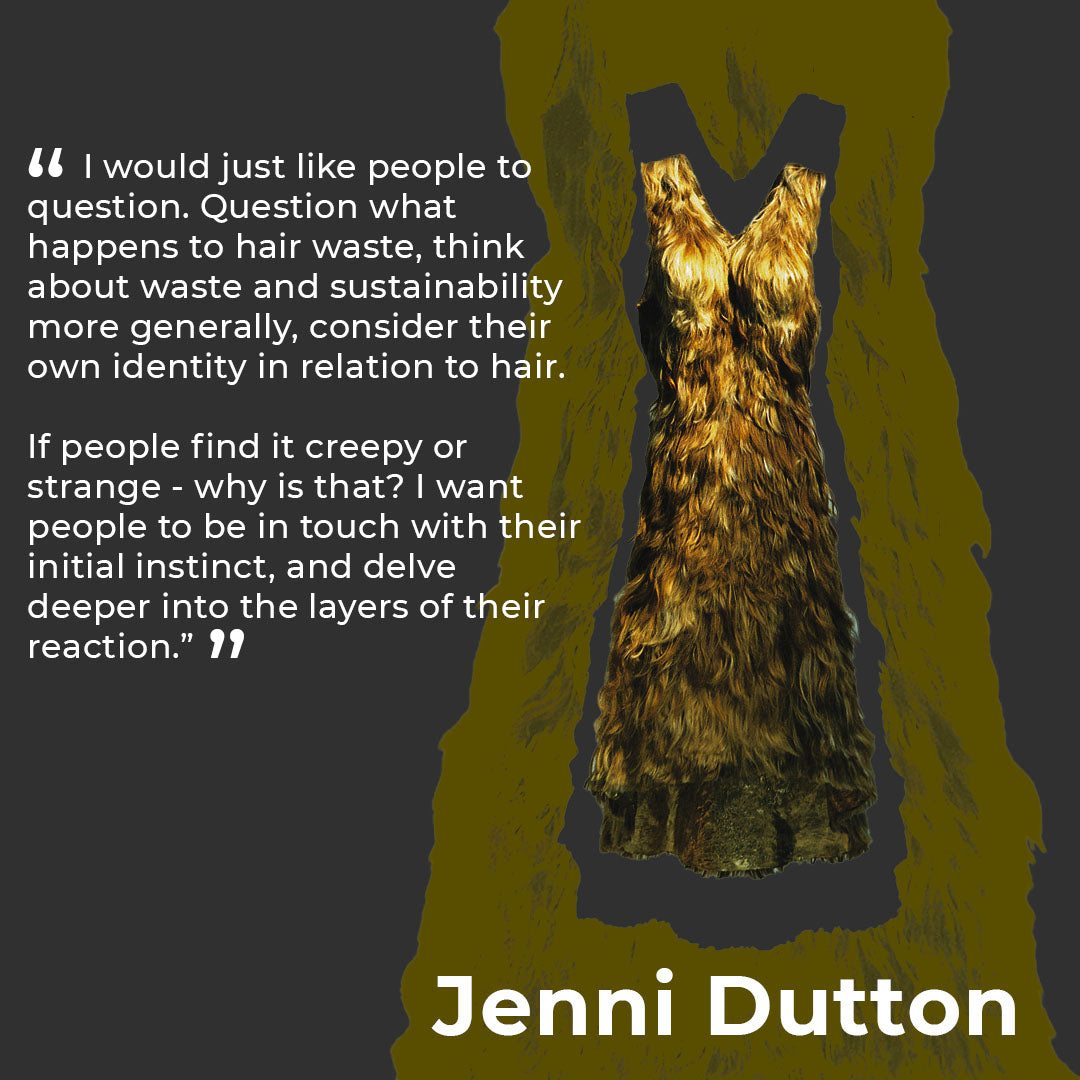
Meet Jenni Dutton, an artist making dresses from waste human hair
One of the ways that we reuse and recycle hair is through supporting artists interested in waste and hair, by giving them hair waste and allowing them to turn it into something totally new. One of our partners who we are planning to work with to create a whole dress covered in waste salon hair is Jenni Dutton, an artist working in Somerset. Keep reading to discover more about Jenni’s work, and how she incorporates hair waste into her art... extracts taken from conversations with the artist.
Tell us about yourself and what you do?
I’m a multi media artist who has been working full time for 25 years, before which I taught in a comprehensive school alongside practising my art. In recent years, I’ve worked on textile portraits known as the Dementia Darnings, as well as works associated with climate activism.
In the past 3 months, I’ve been thrilled to go back to working on conceptual clothing.
What themes come up most frequently in your works?
Often I’m thinking about the female form and women’s experiences, but recently doing work on the climate crisis I realised that a lot of my work has naturally been sustainable - without thinking about it much at the time! I really try to honour those discarded objects - hair, shed snake skins and even the trees that make the newspaper that I use for the base of the dress model. My only ‘un-sustainable’ material at the moment is PVA glue! I’m thinking about that one about any other solutions.
What made you interested in making dresses?
I grew up in the 50s and 60s, which offered via story books and film an idealised version of women wearing flowing dresses, and I always been fascinated with myths and legends mentioning shapeshifting incorporating dresses. They’re symbols of fantasy and femininity and there are so many stories about the potency of women’s hair. There’s something visceral about using human hair, people have an innate reaction to it - whether they think it’s creepy, repellent or whether they are drawn to lovingly stroke the surface.
Talk us through the process of creating one of your dresses, how long it takes and what steps you have to go through?

I tend to start with an initial idea and that develops during the making. Using old newspaper, or plain newsprint, I create the body of the dress and then work attaching the hair from the bottom up. The good thing about paper is that it is recyclable, not very expensive and easy to find!
To attach the hair to the dress, I first have to ‘process’ it. Once I have collected the hair, I sort through to find the lengths and colours that I need and then wet and dry it to remove the kinks and make it easier to handle. After it dries, I comb the hair and then add a small amount of glue to the end, layering it carefully onto the paper form.
It can take me about 6 months from start to finish. I have a couple of dresses on the go at the moment, both in lighter shades, which gives greater contrasts.
How did you become interested in using hair as medium? And how did that develop into the hair dress?
I’ve been making conceptual clothing for over 20 years, often working with natural materials like feathers and tree bark. I was having my hair cut at my local salon and chatting to a past student, and asked him what happened to the hair once it was cut. I found out it was just discarded.
I spoke to the salon owner and was able to collect large bags of hair to use in my work.
My original hair dress has been shown in many venues around the country, and was eventually bought by the Horniman Museum in London which was great because it meant I could get it out of my studio and be protected from moths! I shall develop this current series by incorporating hair with other materials for example shed snake skin.
What challenges have you found with making a dress from hair?
Collecting and getting the hair has been easy thanks to the support of my local salon Combers in Taunton. I designed a poster about my work so that clients knew where their hair was going and what it was being used for.
Sometimes working with hair as a medium can be challenging - especially when glue is involved! I’ve got to be careful not to get glue on my hands or for it to transfer onto the rest of the hair, or it becomes a sticky mess that can’t be used. It’s a learning process and takes patience!
One unexpected side effect of working with hair has been having strands of hair pierce my skin, so now some knuckles have become swollen and sore. Thankfully it can be fixed with some steroid cream and wearing gloves whilst working. A unique challenge!
What is something you hear a lot when people find out you create with human hair?
There are a few different reactions, most people instinctively go to touch their hair, to protect it. People typically take it quite personally too, making jokes about the current state of their own hair People can find it quite creepy and challenging, however there have been some generous reactions too. A few women, usually mothers and daughters, have cut off their long pigtails and donated them. I always find that everyone has a story about hair - when they dyed it, or when it was very long or cut very short, and what it means to them.
A lot has changed in the topics of gender and sexual stereotyping since I first started making hair dresses in 2001, which has made the work have new layers of interpretation and interest.
What would you like people to think about when they see your works?
I would just like people to question. Question what happens to hair after it is cut and discarded, think about waste and sustainability more generally, consider their own identity in relation to hair. If people find it creepy or strange - why is that? I want people to be in touch with their initial instinct, and delve deeper into the layers of their reaction.
Why is it totally normal to wear animal skins like fur, or even faux fur, but not human hair? Hair is so political, it can spark so many interesting thoughts about race, religion, gender, strength, fantasy and more, so I would like people to sit with that and question everything.

What’s next for you, and your work with waste hair?
I’m enjoying working on several dresses at the moment, and am hoping to make one dress completely from waste Green Salon Collective hair. I also want to make more clothing - like shoes or a cloak, both made from hair. I have a 2024 commission from the Fashion Institute of Technology in New York for a hair dress, which will be exciting to work on!
We hope that you find Jenni’s work as intriguing as we do, and watch this space for updates on the GSC hair dress. Let us know in the comments how the idea of a hair dress makes you feel, what do you want to question?
Images courtesy of Jenni Dutton


